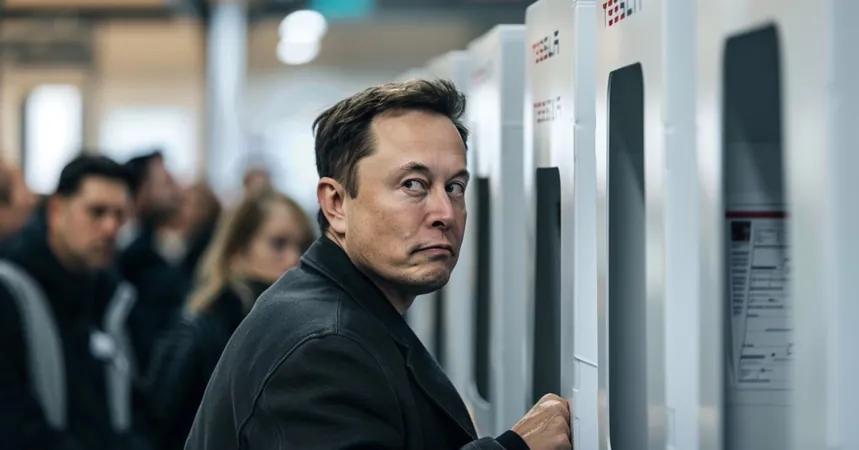
Major Changes Ahead: EU's USB-C Charging Directive Set to Revolutionize the Tech Landscape
2024-12-27
Author: Ming
As of December 28, 2024, a sweeping directive will transform the way tech devices charge within the European Union. The mandate, officially known as Directive 2022/2380, requires that a significant number of electronics sold in the EU utilize USB-C for charging. This groundbreaking legislation aims to reduce e-waste significantly and address the fragmentation present in the consumer electronics market, particularly following Apple’s disputes with EU lawmakers regarding proprietary charging solutions.
Simplifying Charging Options
While the push for USB-C connectivity is the most notable aspect of the directive, it encompasses additional regulations designed to enhance the user experience. These include guidelines on fast charging standards, a requirement for manufacturers to separate charging adapters from device sales, and improved labeling for consumers. If the directive's goals are met, tech enthusiasts in the EU can expect a smoother charging experience across diverse products.
Back in June 2022, member states and the European Parliament reached a provisional agreement on this common charging solution, which was formally approved later that year. While the outright mandate goes into effect in late 2024, the groundwork is already being laid for a more uniform charging ecosystem.
Defining Scope and Compliance
The directive defines "radio equipment" broadly, capturing a wide array of devices that communicate or process information wirelessly. This includes smartphones, tablets, gaming consoles, and various accessories. Notably, devices with power ratings exceeding 100 watts, like the PlayStation 5, fall outside the directive's purview, while devices with lower ratings must comply.
However, ambiguities remain. Drone chargers, for instance, are not explicitly included in the directive, leaving questions about their future compliance. The European Commission has committed to ongoing assessments to ensure relevance as the technology landscape evolves.
The USB-C Transition and Sales Impact
As of now, most devices already utilize USB-C connectors—making the transition relatively seamless for consumers. Even Apple, which previously held out with its proprietary Lightning port, has integrated USB-C on many of its latest products. The directive does not mandate the elimination of proprietary ports but stipulates that devices must have USB-C charging capabilities.
Retail implications are profound; devices lacking USB-C connectors will not see market approval post-deadline. For instance, Apple is anticipating the discontinuation of its iPhone 14 and Lightning-based accessories in the EU market. Meanwhile, existing inventory will remain available for sale until it runs out, encouraging retailers to adapt responsibly.
Streamlining Fast Charging
The directive also tackles the inconsistent landscape of fast charging. By establishing a standardized definition—charging at more than 5 volts and 15 watts—it demands that all qualifying devices adopt USB Power Delivery (USB PD) protocols. This change ensures that consumers can use fast chargers without compatibility issues, although the full impact may take time to resonate in consumer practices.
Reducing Waste and Promoting Sustainability
Additionally, one of the directive's fundamental goals is sustainability. By allowing consumers to buy devices without additional chargers, the EU aims to diminish the excessive waste generated by unused power bricks. This trend aligns with industry practices; many companies—including Apple—have ceased bundling chargers with their devices.
To assist consumers, the EU will introduce clear graphical representations on packaging. These visuals will indicate whether a charger is included and clarify power requirements for the device, thus enabling shoppers to make informed decisions.
Enforcement and Future Outlook
The success of this directive hinges on enforcement, which will depend on each EU member state. Fines and mandatory recalls of non-compliant products could be implemented, but the challenge remains in monitoring the influx of non-compliant goods, particularly from smaller manufacturers.
Despite uncertainties, the USB-C charging directive symbolizes progress for tech consumers in the EU. While the transition was already underway, the directive has accelerated adoption, particularly among major players like Apple. As technology continues to evolve swiftly, how well these regulations adapt to emerging devices and solutions will be pivotal in shaping the future of charging standards in Europe.
Could this be the turning point towards a universally compatible charging future? Time will tell, but consumers are undoubtedly in for a cleaner, more efficient tech landscape with the arrival of the USB-C mandate.



 Brasil (PT)
Brasil (PT)
 Canada (EN)
Canada (EN)
 Chile (ES)
Chile (ES)
 Česko (CS)
Česko (CS)
 대한민국 (KO)
대한민국 (KO)
 España (ES)
España (ES)
 France (FR)
France (FR)
 Hong Kong (EN)
Hong Kong (EN)
 Italia (IT)
Italia (IT)
 日本 (JA)
日本 (JA)
 Magyarország (HU)
Magyarország (HU)
 Norge (NO)
Norge (NO)
 Polska (PL)
Polska (PL)
 Schweiz (DE)
Schweiz (DE)
 Singapore (EN)
Singapore (EN)
 Sverige (SV)
Sverige (SV)
 Suomi (FI)
Suomi (FI)
 Türkiye (TR)
Türkiye (TR)
 الإمارات العربية المتحدة (AR)
الإمارات العربية المتحدة (AR)